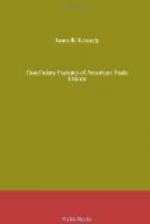| | | |
Wood Workers. |$60 for 1 yr.|$100 for 1 |$ 50 for 6 mo. |$150 for 1 yr.
| |yr. | 75 for 18 mo.| 200 for 2 yrs.
| | | 100 for 3 yrs.| 250 for 3 yrs.
| | | |
Metal Workers.|$75 for 1 yr.|$500 for 5 |$75 for 1 yr. |$500 for 5 yrs.
| |yrs. | |
| | | |
Glass Workers.|$50 for 6 mo.|$150 for 1 yr.|$150 for 1 yr. |$ 75 for 1 yr.
|100 for 1 yr.| | 175 for 2 yrs.| 100 for 2 yrs.
| | | |
Boot and Shoe |$50 for 6 mo.| | $50 for 6 mo. |$100 for 2 yrs. Workers. |100 for 2 yrs| | 100 for 2 yrs.| ----------------------
-----------------------------------------------------
The ratio of disability benefits paid to death benefits paid varies in the different unions according to the definition of disability adopted. The Iron Molders’ Union, which took the initiative in adopting a national disability benefit, undertook to pay benefits to all disabled members, with two exceptions. First, the disability must not have been caused by dissipation, and secondly, the member must not have been disabled before joining the Association.[107] The Granite Cutters’ Union, however, when establishing their voluntary insurance association in 1877, limited the benefit to members disabled for life by any real accident suffered while following employment as a granite cutter.[108] The two benefits were unlike in that the Iron Molders paid the benefit no matter how the disability had been incurred, while the Granite Cutters paid only when the disability resulted from a trade accident.
[Footnote 107: Constitution of the Iron Molders’ Union of North America, 1878 (Cincinnati, 1878), p. 51.]
[Footnote 108: Constitution of the Granite Cutters’ International Association of America, 1877 (Rockland, 1877), p. 27.]
Some of the unions now paying the disability benefit, as for example the Boot and Shoe Workers, have followed the policy of the Iron Molders in paying the benefit in all cases of disability; while others, for example the Brotherhood of Carpenters, pay only where the disability is incurred “while working at the trade.” Under this system, in the case of the Iron Molders, the claims for disability were so numerous that in 1882 the term “permanent disability” was defined to mean “total blindness, the loss of an arm or leg, or both,” and since 1890 also paralysis.[109] Similarly in 1880 the Granite Cutters defined more exactly what constituted total disability.[110]
[Footnote 109: Constitution, 1882 (Cincinnati, 1882), Art. 17; Iron Molders’ Journal, Vol. 16, June and August, 1880; Constitution, 1890 (Cincinnati, 1890); Constitution, 1902 (Cincinnati, 1902), p. 40.]




